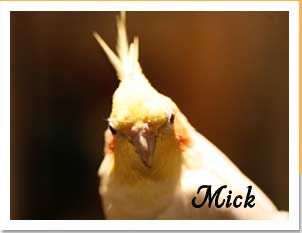Don't Underestimate Budgies
By Michelle YesneyWhen most people think of pet birds, they think of budgies (parakeets in the U.S.). The smallest hookbills, 30 grams and about 4 inches long. The first pet of dozens of children. What they usually remember is one forlorn little bird in a small cage with a swing, a cuttle bone, a small dish of gravel, and a couple of dowel perches. He lived on a seed diet (Hartz Mountain, bought at the grocery store), with (maybe) an occasional small dish of “treat” (yellowish powder with a few seeds in it).
If he was a very lucky little bird, someone in the family tried to tame him, clipping his wings and taking him out of the cage to ride around on a shoulder. He might be allowed to wander around on the dining room table while the family ate dinner, sampling everyone's plate. In some cases, he learned to talk, picking up the family's heavily emphasized phrases (“Hurry up! You're late! Make your bed! Pick up your toys!”) He bathed in his water dish, pooped on the furniture, and scattered chaff from his seed every time he flapped his wings (at least – that's what your mom always remembered).
Even with his unhealthy diet, if he came out of his cage to play regularly your little budgie probably lived at least ten years – many times to 15 or more years.
Some people have somewhat blurry or indifferent memories of the little bird that lived in an empty boring little cage. Cleaning the cage was a pain, your budgie didn't talk, he bit you when you poked him through the bars. Others have a positive memory of a colorful small bird, full of energy, and anxious to be part of the family's life.
The saddest part of these memories is all of the potential that was wasted. Budgies, like virtually all birds, have varying and interesting personalities and given the proper environment, play and argue and find endless ways of entertaining themselves and everyone around them. Placed in a small carrier, many budgies will try to turn themselves inside-out in the corners. If you put several budgies together, they constitute their own soap opera, gossiping and chasing each other and switching partners at will (http://mickaboo.org/our-birds/frame3207.html), like the Holidays on our website. In the morning, the males will congregate after breakfast to exchange stories and do a little boy-bonding. The females will sit at opposite sides of the cage, watching the little group of males for any sign that they might be enjoying themselves excessively.
Then everyone gets on with the business of the day – swinging, chewing up shredders and other crunchable toys, ringing bells, slamming noisy toys around, arguing about politics and carrots. Budgie business is endless and varied. At some point, the male budgies go to work, sitting near each other and “budgering” – gurgling and chatting and mumbling softly, making a gentle torrent of waterfall budgie noises to fill the household with the sounds of happy, contented birds.
When it's time to come out and play with people, they will cling to the side of the cage and call out for attention. Sometimes they make the demanding “budgie squawk”, sometimes they do it in people language: http://www.youtube.com/watch?v=jQyDHtx2AP
A cageful of budgies makes a home more home-like, a life more lively, and a dull day will cease to be dull when it's full of birds of every color. If you think you've outgrown budgies, then you've just never really become acquainted with them at all.

